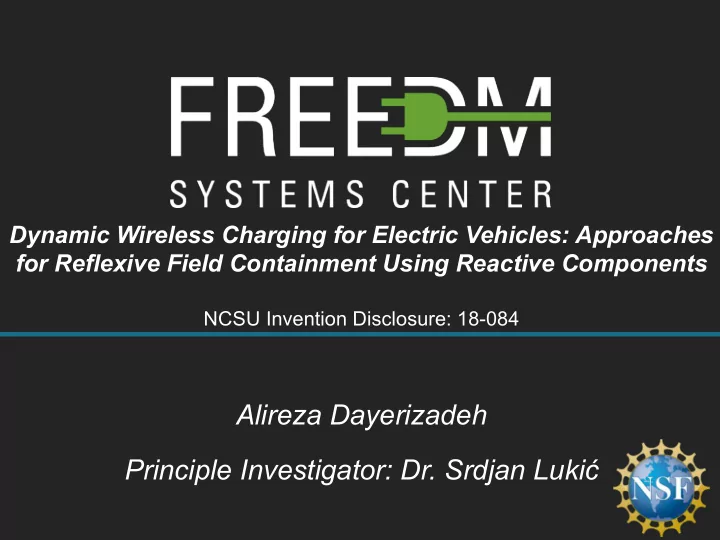

Dynamic Wireless Charging for Electric Vehicles: Approaches for Reflexive Field Containment Using Reactive Components NCSU Invention Disclosure: 18-084 Alireza Dayerizadeh Principle Investigator: Dr. Srdjan Lukić 1
Dynamic Wireless Power Transfer Wireless Power Transfer: An Alternative to Conductive Charging. • Source to load efficiencies of over 90% are possible at coupling coefficients of 0.2. Why Dynamic Wireless Power Transfer? • Increased range and reduced charging times. • Reduced vehicle energy storage requirements Electric-vehiclenews.com. (2018). UK To Test Dynamic Wireless Charging For Electric Cars. [online] Available at: http://www.electric-vehiclenews.com/2015/08/uk-to-test-dynamic-wireless-charging.html 2
Dynamic Wireless Power Transfer Dynamic WPT may be accomplished through an array of segmented transmitting coils that sequentially couple to a passing receiving coil, thus isolating the field emissions to the coupled coil. Challenges include: • Precise Receiver Position Feedback is required. • Efficient and fast methodology to selectively energize coupled coil. 3
Dynamic Approach One Position sensor and relays for power flow control to coupled coils. 4
Dynamic Approach Two Power each coil with a dedicated inverter (cost prohibitive in large applications). 5
Dynamic Approach Two Exploit reflected impedance of receiving coil to control emitted field reflexively 6
Reflexive Field Containment Approach Series-Parallel-LCC 2 M R w 2 w 2 w 2 ( M ) M M = = eq × 2 - × = - × Z n n j ( Q n j ) M reflected Total 2 Z L L L s s s s C 1 C p When Uncoupled… C 2 • Large uncompensated L p L s R eq reactance ln uncoupled TX coils When Coupled… C pn C p2 • Reflected reactance brings L F TX coil into resonance C F C p1 L pn L p2 Inverter C comp L p1 • Current flow is boosted Allows for Segmented TX Coils 7
Transmitter Design Coupled I S Uncoupled I t,uncoupled L F I t,coupled C F I Ccomp Δ X R r V s C comp V V = D = I s I s t coupled , t uncoupled , R j X r 8
Improving Field Containment Transmitter Receiver M C p L max C 1 R eq V in L p L s C 2 Saturable Inductor increases reactance in TX coil. The Saturable inductor: • Maximizes the difference between coupled and uncoupled currents in the TX coil. • Saturates as the system becomes coupled. L Max • Improves system current gain (and field attenuation performance). 9
Saturable Inductor Characteristics • AC current means that inductor is not continuously saturated. • Inductance must be modelled to account for AC saturation behavior. 2 L I I I [ ( ) ] - = 1 + - 2 L max sin sat sat 1 ( sat ) eff p I I I peak peak peak 4 L I [ ( )] = - 1 L max sin sat eff p I peak 10
Simulation – Comparison to Reference System Reference System System With Saturable Inductor Current gain 11 Current gain 3 11
Hardware Validation Transmitter (TX)* Receiver System Inverter Output Voltage and Current - Uncoupled L p 190 uH L s 237 uH C p 22.65 nF C 1 16.56 nF L max 180uH C 2 82.81 nF L eff 23uH n 6 C sat 143nF R Load 7.5 Inverter Output Voltage and Current - Coupled 171.1 V Input Voltage Input Current 8.65 A Input Power 1480 W Output Power 1208.4 W (95.2^2/7.5) Efficiency 81.6% Current Gain 11.1 12
Conclusion • Entirely passive field containment approach for the dynamic charging of electric vehicles. • Builds upon previously published work. Impacts • Aid in the proliferation of electric vehicles. • Aids in the meeting of field emissions standards. • Technology may be used in: autonomous vehicles and consumer electronics. 13
Recommend
More recommend